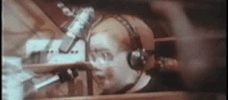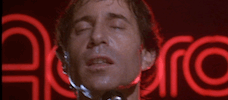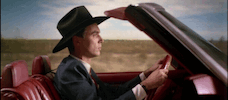Reviews
Bernard Shakey (a.k.a. Neil Young)/Dean Stockwell
USA, 1982
Credits
Review by Jonathan Foltz
Posted on 12 December 2010
Source DivX
External links
Related video at Doom & Gloom from the Tomb
Categories Rock Follies
Now there’s a real human being: Franky Fontaine!” — Lionel, speaking to his wooden Indian
As everyone knows, rock stars are not real people: they are mythic fabrications, inchoate fantasies born of our desire to escape the stifling conditions of normalcy. From this perspective, Neil Young’s indulgent, bewildering - but also amazing - Human Highway, directed (with Dean Stockwell) under his pseudonym “Bernard Shakey,” represents at once an extreme rejection of rock celebrity and its utter apotheosis. The film, an ostensible vanity project - Young spent 3 million dollars of his own money over the span of four years - finds Young at his most weirdly self-effacing. Surrounded by a cadre of counter-culture artist-celebrities (Dennis Hopper, Dean Stockwell, Russ Tamblyn) and overshadowed in musical screen time by his collaborators, Devo, Young’s performance as the impish and nerdy Lionel Switch seems willfully quiet, campy and character-driven - the complete opposite of the sort of charismatic star turn one would expect. Gone is the dark, brooding Neil of Journey Through the Past. In his place is a short-haired, bespectacled gas station attendant and car mechanic who dreams of one day making it big in the music business, just like his idol Franky Fontaine (also played by Young). By casting himself stridently against type, Young strives to comment upon the dead ends of celebrity culture, while ultimately becoming a testament to its manic excesses.
The film’s intentions in this respect are quickly visible in the opening scene, which finds Booji Boy (Devo’s Mark Mothersbaugh) standing amid the smoking remains of the fictive town of Linear Valley after what we later learn has been a massive nuclear blast. Wandering through the wreckage in his orange jump suit and eerily synthetic baby-mask, Booji Boy stands over glowing vat of nuclear sludge, spouting surreal, Dylanesque obscenities for the camera:
How many children will dive to their death, / In the pool that no one has seen? / And how many hands will squeeze pulsing pickles bright and orange, / Spewing liquid - vile and green? / … The answer my friend / Is breaking in the wind, / The answer is sticking in your rear.”
The scatological irreverence of these lines, which openly deface the pious idealism of Dylan’s 60s anthem, show just how little interest Young has in preserving a sense of folkie authenticity or earnestness. Instead, the film adopts a manic style of neon colors, fake sets, cheesiness, and juvenile plotting. Human Highway details a day in the life of Lionel Switch and his friends at a small town diner, on the eve of the nuclear meltdown whose wasteland aftermath is shown in the first scene. There are signs of impending doom from the beginning, from the previous owner of the diner who has died the day before of radiation poisoning, to the disconcerting “rollers” - nuclear earthquakes - that wreak havoc on the town. (The cook, Cracker, predicts their appearance when the raccoons who he has been feeding pancake batter suddenly vanish: “Coons are gone! Coons are gone! There’s a roller common’!”). These troubling omens are underscored by the intermittent appearance of Devo, who play a team of “Nuclear Garbagemen” dumping waste barrels around the town - they are dubbed the “glow boys” for their radiant chemical luminescence - and even provide the film with a musical interlude like a swarm of toxic oompa-loompa’s. The song they perform - a new wave version of the folk classic “It Takes a Worried Man” - exemplifies the mixing of styles in the film, just as much as it points to its theme of impending apocalypse. “It takes a worried man / To sing a worried song,” go the lyrics, “I might be worried now / But I won’t be worried long.” This is the story of a community caught up in the petty machinations of daily life - finding a job, getting an audition, tending a budding romance - but apparently unaware of the widening fissures in the ground underneath their feet.
Meanwhile, Lionel’s hero, the aforementioned Franky Fontaine, a sleazy lounge act lothario and music idol, comes to town to have his car repaired. Transfixed in the presence of his hero, Lionel loosens a gasket while under the car, knocking himself out and inadvertently guzzling mouthfuls of engine fluid. This traumatic event leads to a sprawling and directionless dream sequence in which he imagines himself as a rock legend. The footage for this dream sequence, however, doesn’t take place in the same artificial world as the rest of the film: it is comprised of real concert and tour footage, with backstage excesses and drugged out delirium, filmed with Neil and members of the cast “acting in character.” It is also, unquestionably, the worst part of the film. At one low point, Neil (a.k.a. “Lionel”) takes the crew down to a reservation and gets high while dancing vaguely around a burning pile of wooden Indians. Such scenes are supposed to represent the imagined heights of rock stardom, but they show instead its crazed reality, the desperate, nihilistic orgy of power and ego (including brief footage of Young receiving a “milk bath” from a female cast member). Far from offering a glimmering narrative of fame as wish fulfillment, these scenes depict Young as a celebrity clumsily searching for something left to feel.
The capstone of the dream sequence, however, is a twelve minute jam session between Neil Young and Devo, which documents what was apparently one of the earliest recordings of “Hey Hey My My,” as sung by Mothersbaugh in his Booji Boy character, sitting in a crib while Young thrashes around beside him humping the crib with his guitar. It is an unpleasant spectacle, but undoubtedly curious from a historical point of view. “Hey Hey My My” is a song about renewing rock’s identity in the image of punk aesthetics, and Young’s touchstone in this respect was clearly less the furious negation of the Sex Pistols (as the lyrics of the song would lead you to believe) than the rigid absurdism of Devo. (The title for the album that included “Hey Hey My My,” Rust Never Sleeps, was borrowed from Mothersbaugh, who changed the lyrics during the session to fit one of the advertising slogans he had devised for a rust inhibitor years before in Akron, Ohio.)
However, if the performance of the song points to a continuing affirmation of rock principles, and to the formative impact of Young’s stylistically unexpected collaboration with Devo, in the context of the film it starts to take on more ambivalent associations. Lionel’s dream of becoming a rock idol is remarkably hard to distinguish from Young’s desire to escape the trappings of stardom. In fact, it is telling that in the décor, production and execution of these scenes the emphasis is reversed: the dream is shot in verité style, with a shaky camera and noisy image tracking Young and his entourage through their elliptical pursuits, whereas the film’s “reality” in Linear Valley is full of bright colors and paper thin sets with phony backdrops.
The transcendent weirdness of the film’s frame story has often been compared to the style of David Lynch, an appraisal that is justified by more than just the telling overlap of actors.1 Human Highway predates both Blue Velvet and Twin Peaks, but with its atmosphere of twisted humor, odd sincerity and impending horror, the film offers its own take on the same small town mythos that Lynch would later mine, albeit with greater success. The most unforgettable moments of Human Highway show Young’s characteristic fascination with “ordinary people,” but bent manically towards its most off-kilter expression. The dumbstruck look on Lionel’s face as he does a turn of unending double takes at Charlotte’s pouty lips, his ongoing conversation with his wooden Indian, or the film’s grand finale musical numbers featuring the entire cast dancing ecstatically while trying to find shelter from the looming apocalypse - these scenes showcase the collective giddiness of Young’s vision of Linear Valley, and will certainly reward a sympathetic viewing.
Human Highway is really a film about the dream of escaping celebrity for the careless pleasures of the simple folk, a skewed, synthetic vision of what regular life might be like in some alternate universe. Indeed, according to producer/cowriter Jeanne Field, it was the musical dream sequence that Young increasingly regretted as the production wore on: “Neil said, ‘I wish I hadn’t chosen to play a musician in Human Highway. I don’t know what else to do with the character. I don’t want this to be a music film. I want it to go somewhere else.’”2 Young’s disinterest in the music world carries over into the film, which stands much more compellingly as a testament to the oddity of Lionel’s slapstick normalcy than to the impersonal nightmare of rock stardom. In this respect, Human Highway is a rock film that succeeds most when it “goes somewhere else,” and embraces its ambivalence towards the culture that birthed it.
- Russ Tamblyn would go on to play “Dr. Jacoby” on Twin Peaks, while Charlotte Stewart, another Peaks regular (here playing Lionel’s love interest, Charlotte), was a veteran of Eraserhead and a number of Lynch’s short films. Hopper and Stockwell, of course, would both have haunting turns in Blue Velvet. ↩
- Jimmy McDonough, Shakey: Neil Young’s Biography, 575. ↩
More Rock Follies
-

Head
1968 -

Sympathy for the Devil
1968 -

Alice’s Restaurant
1969 -

200 Motels
1971 -

Journey Through the Past
1972 -

Human Highway
1982 -

Renaldo and Clara
1978 -

One Trick Pony
1980 -

Give My Regards to Broad Street
1984 -

The Man Who Fell to Earth
1976 -

True Stories
1986
We don’t do comments anymore, but you may contact us here or find us on Twitter or Facebook.



